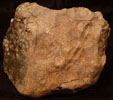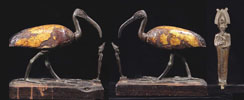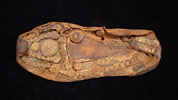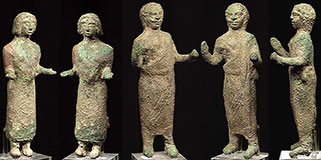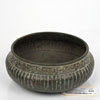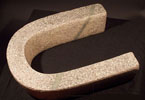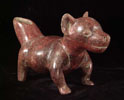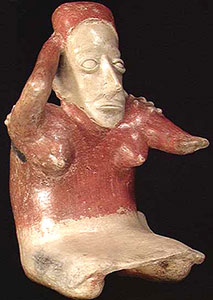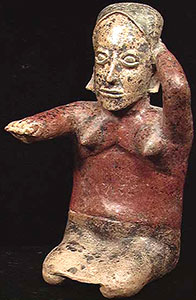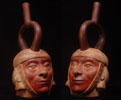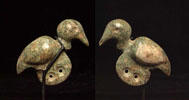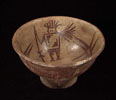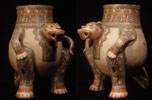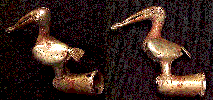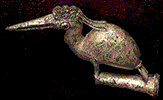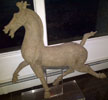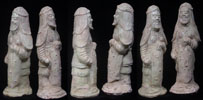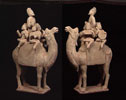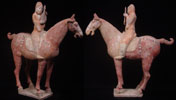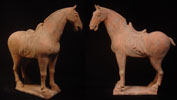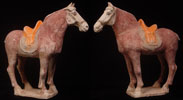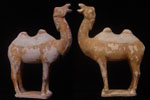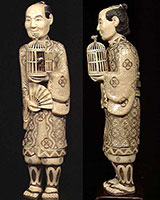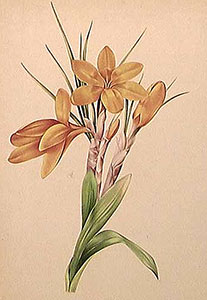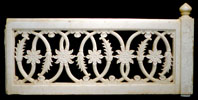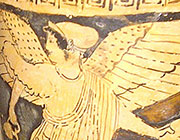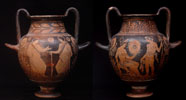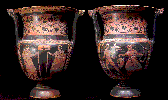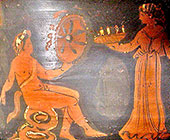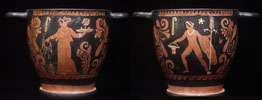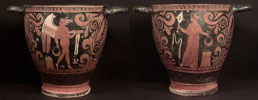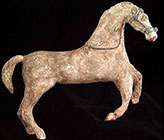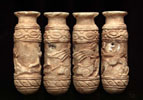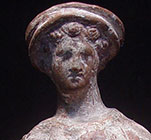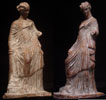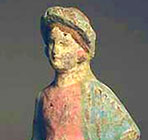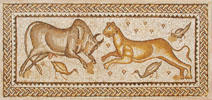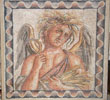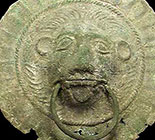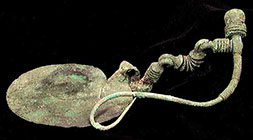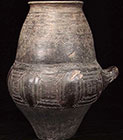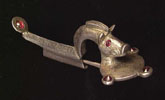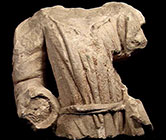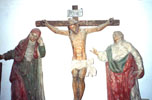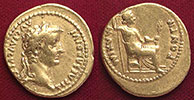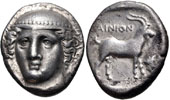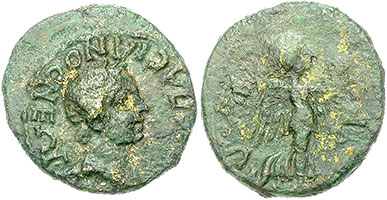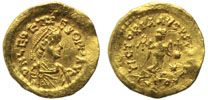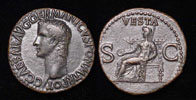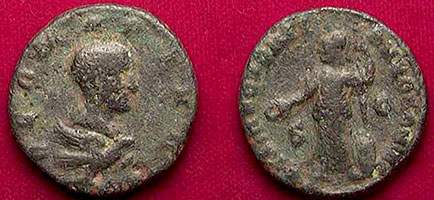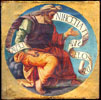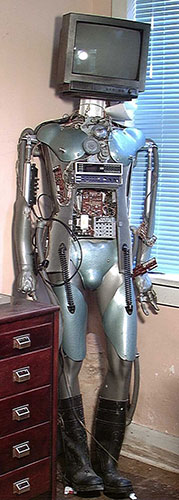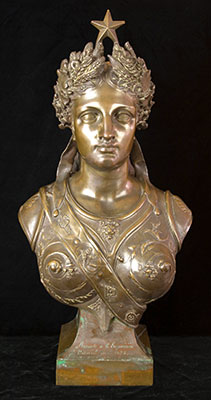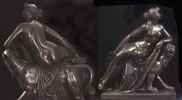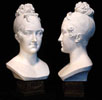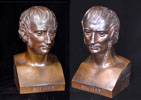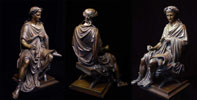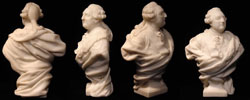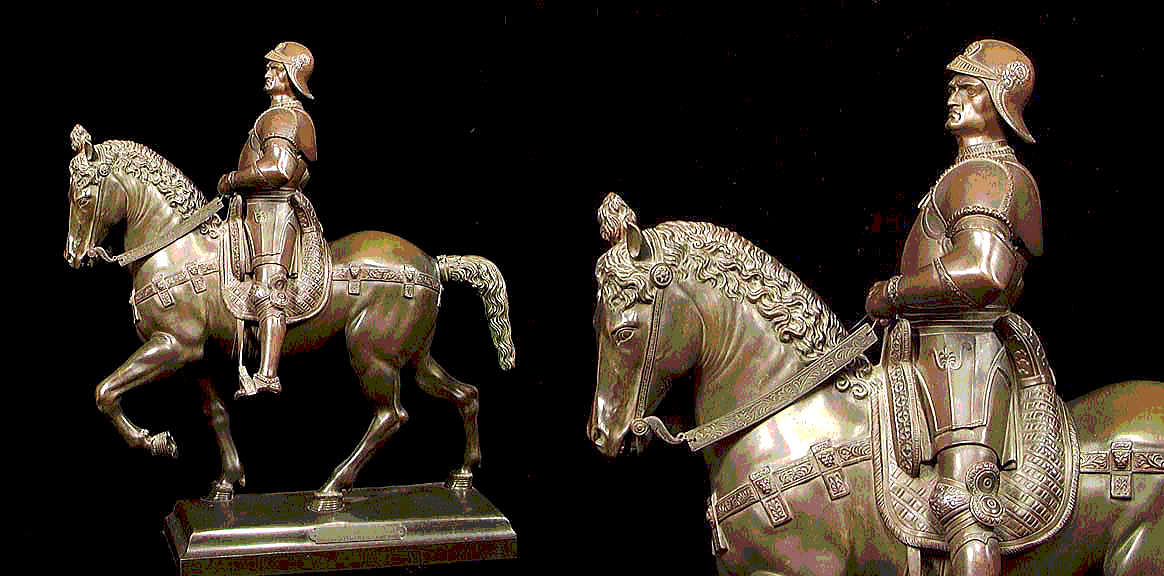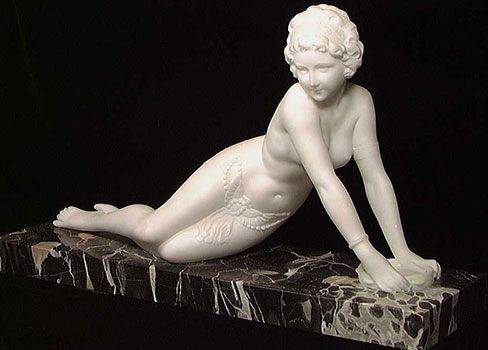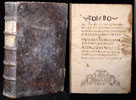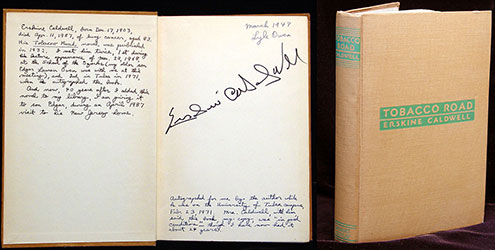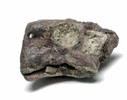Some of the Finest Pieces from our Huge Inventory
EGYPTIAN NEAR EAST GREEK ROMAN MEDIEVAL PRECOLUMBIAN ASIAN NATURE FINE ART SCULPTURE BOOKS COINS
Also available are the following extraordinary pieces of ancient art, all the properties of a European gentleman, all with proper export permits.
1. An important monumental Greco-Roman marble figural group of a beautiful nude Dionysos with a nude Satyr. Height 220 cm. Currently on display at a major European museum.
2. An important monumental Roman marble figure of Persephone. Height 222 cm.
3. A life sized Greco-Roman basalt head of a bearded male.
4. A monumental Greco-Phoenician marble head of a goddess. Height 48 cm.
5. A fine Roman marble stele of a lady. Height 60 cm.
6. A large Han Dynasty style (18th century?) marble flying horse of exquisite form. 95 cm.
7. Two exceptional large Greek marble statues.
Photos and prices are available upon request to qualified customers. Interested parties may contact us at Edgar@EdgarLOwen.com for details.
EGYPTIAN ART
ATTRIBUTED BY DR. ROBERT S. BIANCHI 12962. COLLOSSAL LIMESTONE HEAD OF A SPHINX. Late Period to Early Ptolemaic Period, c. 500-250 BC. 24" tall x 17" wide x 21.5" deep. 28" tall counting the base. Shipping weight with included custom crate 309 lbs. The over life sized head is dominated by large hieroglyphic eyes, their upper and lower lids clearly defined and well preserved, set into shallow sockets. The lips of the mouth with their drilled corners are drawn up into a smile. The head wears the traditional Nemes headdress ornamented with a series of stripes in the form of raised and recessed planes. The headdress is fronted by a sacred uraeus cobra, its coiled tail arranged as a horizontal figure-8 parallel to the frontal band. Condition: There is some restoration to the right cheek. This is probably the side where it landed when it would have originally fallen from the body. This side of the face has patches of restoration at the cheek and toward the missing ear. The Nemes head cloth and ear on the left side are nearly all complete and in good detail. The damage is to the right side where the head cloth and ear have been lost and the right cheek has been patched. Provenance: Swiss collection in the 1970s and came to the U.S. then. Current owner purchased it from the collection in 2010. Note the photos are somewhat distorted due to being taken closeup. The proper perspectives are shown more accurately in the documentation. Side view. Right side view. Frontal view. Documentation.
Dr. Robert S. Bianchi is a renowned author and art curator. See Bianchi 1 and Bianchi 2 for details and biography.
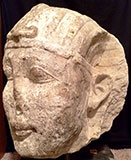
12960. FINE EGYPTIAN SARCOPHAGUS. Late Period, 712-332 BC. 72 inches in height. With vertical rows of hieroglyphs both front and back. Some areas of paint loss on back of head. In custom plexiglas case. A classic, very finely carved and painted Egyptian sarcophagus. No repair or restoration or repainting. Provenance: The property of a wealthy Northeastern collector. Purchased in the late 1960's from a Manhattan antiquities dealer. Side view. Side view. Back view. Oblique view.

11597. EGYPTIAN MUMMY MASK, 1st millennium BC. 13 h x 15 w x 10 d inches. Very finely styled exempt with detailed designs in gold leaf and gesso on embossed linen. Of very unusual 3-dimensional form with head protruding naturally forward from the neck. Provenance: The European antiquities market. Recently imported into the US where it was inspected and cleared by US customs thus legally in the country. Left side. Right side. Top. Back.
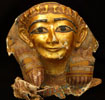
11107. EGYPTIAN MUMMY SARCOPHAGUS. Ptolemaic Period, c. 400 BC. Polychrome gesso on wood. Front View of top section. Closeup. Back of base section. Provenance: From The Princeton Collection.
11109. EGYPTIAN MUMMY SARCOPHAGUS. Ptolemaic period, c. 330-305 BC. Complete with outer matching lid from the same tomb, both pieces constructed of polychrome gesso on wood.. The decoration depicting a winged scarab, the mummy on an embalming table with the four sons of Horus depicted as lids on canonic jars, a Djed pillar on the back with many hieroglyphs on the front. Front. Left side. Right side. Back. Outer matching lid. Dimensions of the outer matching lid are 73" high x 26" wide x 14" deep. [NOTE: the small fragment with the head resting on the outer matching lid is NOT included. It is lot 11106.] Provenance: From The Princeton Collection. SOLD.
NEAR EASTERN ART
FROM THE ARTHUR M. SACKLER COLLECTION, EX SOTHEBY'S 10629. ANCIENT JUDAEAN CARVED LIMESTONE RELIEF WITH MENORAH, c. 1st century BC/AD. 10.5"h x 19"l x 4"d. An exceptional and imposing piece of ancient Judaica. Provenance: The Arthur M. Sackler collection. Collected in the 1970's or earlier. Possibly published in one of the dozen or so books documenting the Sackler collection. Closeup. Side. Back.
SOLD.
FROM THE ARTHUR M. SACKLER COLLECTION, EX SOTHEBY'S 10635. FINELY ENGRAVED ANCIENT NEAR EASTERN BRONZE BOWL. c. 1st millennium BC. With running ibex and reeded decoration, 3.25"h x 8.25"dia. Provenance: The Arthur M. Sackler collection. Collected in the 1970's or earlier. Possibly published in one of the dozen or so books documenting the Sackler collection. Closeup. Bottom.
FINE PRE-COLUMBIAN ART
EX SOTHEBY'S 11532. MAYAN STUCCO HEAD. Late Classic period, 550-950 AD. 23 x 21 cm. With traces of original pigment including the famous Mayan blue. Provenance: An Italian collection. Purchased at Sotheby's New York, Nov. 24, 1997. Donated to Denver Museum of Art in 1970. Good and legal provenance provided to buyer. Right side. Sotheby's listing.
SOLD.

11067. MOCHE HEAD VESSEL, Peru, c. 600 AD. 6 x 6 x 12 inches. Intact. SOLD.
11078. NICOYA POLYCHROME JAGUAR VESSEL, Costa Rica, Nicoya Peninsula, c. 13th century AD. 9 x 12 inches. Head neatly and unobtrusively reattached to body, otherwise all intact and original. Front view. Back view.
ASIAN ART
12885. BEAUTIFUL MUGHAL JADE LOTUS DISH. India, Mughal period, 17th-18th century. 7.25 x 7.25 x 4 inches. Beautifully carved from pale celadon jade with touches of red in the form of open lotus blossoms, the top handle in the form of a lotus seed pod. Excellent condition. Similar Mughal jade bowls and dishes have brought well over $100,000 at Christie's and Sotheby's. Provenance: A midwestern collection. Reverse view. Oblique view. Lid top. Open view. Bottom view.
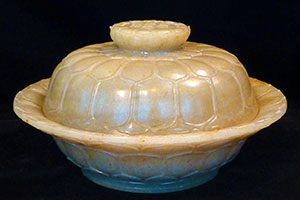
11635. FINE LARGE GANDHARAN STANDING BUDDHA. 1st-2nd century AD. 55 inches height. Beautiful sensitive figure of the Buddha standing. On custom stand. Provenance: Good and legal provenance provided to buyer. Full view. Right side. Left side. 
11513. LARGE GANDHARAN BODHISATTVA. 1st-2nd century AD. 32 inches height. Provenance: Good and legal provenance provided to buyer. Enlargement. Right Side. Left side. Back.

WITH OXFORD TL CERTIFICATE 11112. LARGE HAN DYNASTY FLYING HORSE. Accompanied by an Oxford laboratories TL certificate. Hoof to top of head 42.5", Back hoof to front hoof 46.5", Depth 9". More information and photos pending. Another view.
11111. LARGE HAN DYNASTY STANDING HORSE. More information pending. Another view. 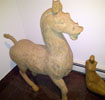
11098. LARGE TONG (TANG) DYNASTY TERRA COTTA HORSE, China, 618-906 AD. On integral terra cotta base, base repaired from a couple of large shards, otherwise intact. 6.5 x 18 x 18.5 inches.
11056. TONG (TANG) DYNASTY TERRA COTTA HORSE, 618-906 AD. Painted in violet and orange, the colors original and intact. 12 x 12 inches.
11095. TONG (TANG) DYNASTY BACTRIAN CAMEL, China, 618-970 AD. The animal in an animated pose with considerable remains of color. 10 x 13 inches. Intact and original.
EX HIS HIGHNESS THE MAHARAJA OF JAIPUR COLLECTION 8403. A PAINTING FROM THE COLLECTION OF H.H. THE MAHARAJA OF JAIPUR, c. 1910. Superbly done scene of a yellow saffron crocus. 4.5 x 6". A true masterwork rendered with a single hair brush. Must be seen to be appreciated. There were two paintings in this collection from the same hand, one with the official seal of the Maharaja of Jaipur. This one unfortunately does not carry his seal. Enlargement.
AUTHENTICATED BY THE BRITISH MUSEUM 11392. FINE SUKHOTHAI HEAD OF A BUDDHA, Sukhothai, Thailand, 15th-16th century. The piece has the typical large hair curls and flame finial typical of the period, as are the high arched eyebrows, downcast eyes, thin nose, edged lips, and long, slightly flaring earlobes. Sukhothai images have an elegant, ethereal appearance that shows the calmness of the Buddha. Sukhothai images are highly original in form, with few identified antecedents, but although fairly short-lived, the style had a major impact on subsequent Thai art. Accompanied by copy of an email from the Curator for Southeast Asian Art at the British Museum authenticating the piece and its dating. Copy will be provided to the buyer. For additional information refer to Hiram Woodward's 'The Sacred Sculpture of Thailand', which has substantial sections on Sukhothai and the following Ayutthaya period with images. Left side. Back. Right side.
SOLD.

MUSEUM QUALITY OF EXQUISITE ETHEREAL STYLE 11457. STUCCO HEAD OF A BODHISATTVA. Gandhara, 1st-2nd century AD. 18 h x 10 w x 10 d inches. Traces of original white glaze and red pigment. On custom stand. A museum quality piece worthy of the finest collection. Provenance: Property of a New Jersey collector. Right side. Left side.

A CHOICE PIECE BASED ON A FAMOUS PROTOTYPE NOW IN THE BRITISH MUSEUM! 11461. PANCIKA AND HARITI. Gandhara, 1st-2nd century AD. 9.5 h x 8 w inches. Carved in grey shist. On custom stand. Provenance: Property of a New Jersey collector. Wikipedia reference with a nearly identical piece from the British Museum.
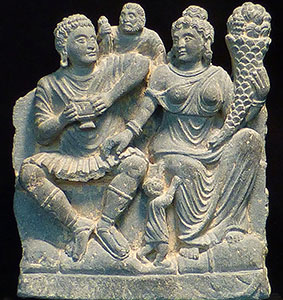
LIFE SIZE 11425. HEAD OF A BUDDHIST PRINCE. India c. 10-11th century AD. Large carved limestone head of a Buddhist prince with Buddhist topknot and wide mustache. 17 x 9 x 8 inches. 50 lbs. On sturdy custom black steel stand. Right side. Left side.
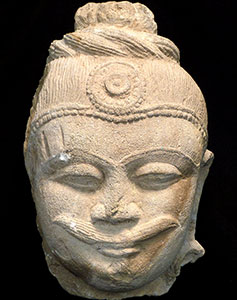
11426. INDIAN STONE FRIEZE. India c. 10-11th century AD. Substantial stone frieze of a heavily breasted four armed goddess holding her attributes and surrounded by attendants. 7 x 14 x 20 inches. 103 lbs. Two heavy steel posts in base ready for mounting. Considerably more three dimensional and with better detail than photo shows. Right side.

GREEK ART
ATTRIBUTED TO THE BOWDOIN PAINTER 11120. FINE ATTIC RED FIGURE LEKYTHOS ATTRIBUTED TO THE BOWDOIN PAINTER EX CHRISTIE'S. Athens, Greece, 5th century BC. Ex Christie's Antiquities sale 6 July 1994.
11507. A FINE MACEDONIAN GREEK SILVER PHIALE OMPHALOS, 3rd century BC., Silver and in excellent condition. 15 cm. diameter. Provenance: Good and legal provenance provided to buyer. From an old Belgian collection since the 1960's with papers. Bottom view. Close up.
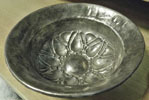
EXCEPTIONAL CONDITION 11510. A VERY RARE GREEK IRON SWORD. 6th century BC. 61 cm length. An exceptional intact example. Ancient iron is rarely preserved this well. Provenance: Good and legal provenance provided to buyer. From an old Belgian collection dating to the 1960's. Full length side A. Full length sideB. Hilt.

ROMAN & ETRUSCAN ART
12887. ROMAN MARBLE HEAD OF HADRIAN. Rome, 2nd-3rd century AD. Portrait head of the Roman emperor Hadrian (117-138). Carved in the round from fine-grained white Roman marble with finely polished surfaces. The 33 cm. height of this piece is slightly larger than life size. It powerfully depicts the emperor with his head turned slightly turned to the left, gaze fixed straight in front of him. His face is framed by thick curly hair and beard. The forehead is broad and smooth, the thick eyebrows are rendered with finely engraved features. The eye sockets are strongly chiaroscuro and his eyes are characterized by elongated eyelids carved in relief. The powerful wide nose increases the stern visage of the emperor. The cheekbones are high and strong, the bottoms of the ears show beneath the curly hair; the mouth is slightly open; the neck has an anatomically accurate modeling. The nose, ears and a few curls are chipped otherwise in excellent original condition. Provenance: A Florentine collection, Ex Dea Moneta. Comes with a 2009 Italian export permit.
With Hadrian begins a series of imperial Roman portraits bearded in imitation of the Greek philosophers. A wonderful classic sculpture that communicates the dignity and authority of this emperor who ruled at the pinnacle of the Roman empire. Left side. Italian export permit page 1. Italian export document page 2.

11680. ROMAN MARBLE BUST OF A BOY, MOST LIKELY THE YOUNG NERO. 1st century AD, Julio-Claudian Period. Finely carved marble bust of a noble boy in Neronic style wearing a toga fastened with a large clasp on his left shoulder quite possibly the young Nero. Compare this nearly identical portrait of Nero as a boy from a Roman gold coin .) 40 x 34 x 17 cm. Break to right shoulder, slight chip to tip of nose, and some slight calcified deposits attesting age. Provenance: Property of an Italian family by descent. Shipped from Italy with official export document from the Italian Ministry of Culture. Left side. Back view. Right side. Export Permit page 1. Export Permit page 2.

12889. ROMAN NUDE MARBLE EROS. Rome, 2nd-3rd century AD. Finely carved classical statue of a winged youth representing Eros as an archer. Carved in the round from fine-grained white Roman marble. 72 x 36 cm. Provenance: A Florentine collection, Ex ACR Auctions, Munich. Comes with an Italian export permit. Right side. Front left view. Rear view. Detailed description.

11637. MAGNIFICENT ROMAN MOSAIC REPRESENTING THE EUPHRATES. 2nd century AD. ~155 x 155 cm. ~160 kg. A very rare subject matter representing the river Euphrates holding grain ears signifying the river's significance to the grain harvest, with identifying inscription. Complete and original save for slight restoration of white tesserae above the head. Provenance: Ex. Christie's sale number 2364 on December 9, 2010 (more details in catalogue). Good and legal provenance provided to buyer. Detail of face. 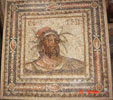
11642. BEAUTIFUL ROMAN GEOMETRIC MOSAIC. 2nd century AD. 96 x 186 cm. Excellent condition. Provenance: Good and legal provenance provided to buyer. SOLD.
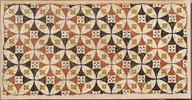
11643. MARVELOUS ROMAN GEOMETRIC MOSAIC. 2nd century AD. 109 x 191 cm. Excellent condition. Provenance: Good and legal provenance provided to buyer. SOLD.
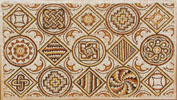
LYCURGUS AND AMBROSIA 11621. A FINE ROMAN MOSAIC, c. 2nd century AD. The mosaic depicting the myth of Lycurgus and Ambrosia within a running wave border. Lycurgus depicted in the act of killing Ambrosia with an axe as she is being transformed into a grape vine. 165 x 198 cm. From the eastern Mediterranean region. Complete and all original. Provenance: Good and legal provenance with import documents provided to buyer. Old American collection, New York, acquired 1988. French private collection,
Lycurgus of Thrace, an antagonist of Dionysus, forbade the cult of Dionysus, whom he drove from Thrace, and in revenge was driven mad by the god. In his fit of insanity he killed his son, whom he mistook for a stock of mature ivy, and the nymph Ambrosia, who was transformed into the grapevine. There is a similar mosaic from Herculanium depicting the same myth now in the Staatliche Museum in Munich. Staatliche Lycurgus and Ambrosia.

FINE MEDIEVAL ART
IMPORTANT TEMPLAR ALABASTER CHALICE 11526. TEMPLAR ALABASTER CHALICE. Romanesque 1160-1223. 16.5 cm high x 13.5 cm wide x 12 cm deep. Incised with Templar cross and three other crosses. Side A. Side B. Side C. Interior. Documentation. Carbon date report of contents. The Symbology of the Chalice. Provenance: An old London collection. Good and legal provenance provided to buyer.

11670. EARLY SPANISH GOLD CROSS WITH 34 EMERALDS. Spain, 17th-18th century. A beautiful and highly ornate Spanish gold cross set with 34 emeralds 2.5 inches in height. No doubt made with Spanish gold and emeralds from the New World judging from the small Pillars of Hercules mark on the back. Intact, wearable with original suspension loop and in excellent condition save for a couple of minute press marks on the reverse. Provenance: Good and legal provenance provided to buyer. Side view. Back view. 
11648. MAGNIFICENT LATE BYZANTINE GOLD CROSS WITH MATCHING PENDANTS. A matching set consisting of a 22kt gold openwork cross, beautifully decorated and set with cabochon garnets each side, slightly out of true but otherwise extremely excellent condition, suspension loop intact, dating to the late Byzantine period, measuring 6.5 cm x 4.5 c, x 0.9 cm. and weighing 24.78 gm. Plus a matching pair of large 22kt gold temple pendants having a beautiful openwork design, and each having a hinged hanging loop with pin, dating to the late Byzantine Period, measuring 5cm in length and weighing 36.46 grams. Good and legal provenance provided to buyer. Front view. Side view. Pendants. Pendants. 
8750. SUPERB ROMANO-BRITISH BOARS HEAD FIBULA, c. early 5th century AD. The finely worked silver fibula terminating in a boar's head with tusks and ridged mane above the head plate, the body decorated with bands of raised silver filigreed 'X's the length of both sides, the three knobs of the head plate and the tail set with garnets, the boar's eyes also set with garnets, the owner's name preceded by a Christian cross inscribed on the catch plate. According to Dr. Richard Hobbs, curator of Romano-British Collections at the British Museum, the inscription reads (cross)ANDIAT most likely making the owner Andiatus a name also attested from an altar at Carvoran. Remains of parcel gilding on the head plate and body. 3.2 inches. Silver pin possibly restored. Ex. Joseph Ternbach collection. A museum quality example of ancient art. Cf. 'Jewelry 7000 Years', ed. Hugh Tait, #354 for a similar but lesser example from the British Museum, PRB 1954.12-6.1 found near Sussex. Inscription view. Left side. SOLD.
AN EXCEPTIONAL PAIR 11509. EXCEPTIONALLY LARGE MATCHING PAIR OF MEROVINGIAN FIBULAS. c. 5th-7th century AD. 18 cm length! Of very fine ornate workmanship in gilt bronze set with multiple garnets. Provenance: Good and legal provenance provided to buyer. From an old Scandinavian collection. Close up of one. Close up of the other.
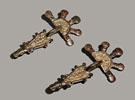
A ROMANESQUE MASTERWORK 11353. EXCEPTIONAL ROMANESQUE LIMESTONE FIGURE OF CHRIST, ca. 11th-13th century. Free standing figure of Christ with right hand raised in blessing, holding an orb with the lamb of Christ in his left. 3 x 2 x 11.5 inches. Very rare. Back view. Provenance: From a large French collection of Medieval Art. Originally acquired at auction in 1986 in Aix en Provence. The title of the sale was "From Gallo-Roman Art to Romanesque Art".

11389. LIFE SIZE 16TH CENTURY POLYCHROME CRUCIFIX. Spain, 16th century. Carved wood polychrome altar piece of the crucified Christ on the cross. Accompanied by a letter from Sotheby's Madrid (in Spanish) authenticating the piece and its dating. Copy will be provided to the buyer. 220 x 160 cm. Paint in generally excellent condition consistent with age. Full length view. Right side. Torso. Hand. More photos available upon request. Pick up or shipping from Madrid, Spain. 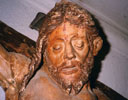
11390. LIFE SIZE 16TH CENTURY POLYCHROME VIRGIN MARY IN ADORATION AT THE CROSS, Spain, c. 1600. Polychromed carved wood altar piece depicting the Virgin Mary in adoration at the cross. Accompanied by a letter from Sotheby's Madrid (in Spanish) authenticating the piece and its dating. Copy will be provided to the buyer. 170 cm. Paint in generally excellent condition consistent with age other than three fingers missing from right hand. Pick up or shipping from Madrid, Spain. Full length view. Back view. More photos available upon request. 
11391. LIFE SIZE 16TH CENTURY POLYCHROME ST. JOHN IN ADORATION AT THE CROSS, Spain, c. 1600. Polychromed carved wood altar piece depicting St. John in adoration at the cross. Accompanied by a letter from Sotheby's Madrid (in Spanish) authenticating the piece and its dating. Copy will be provided to the buyer. 180 cm. Paint in generally excellent condition consistent with age other than two fingers missing from right hand and slight damage to base. Pick up or shipping from Madrid, Spain. Full length view. Right side. Back view. More photos available upon request. 
RARE ANCIENT COINS
CHOICE EXAMPLE! 7669. CALIGULA, 37-41 AD. AE As. /Vesta std. l. EF. Choice example as good as they come.
FINE ART
EX SOTHEBY'S 1999 11695. CIRCLE OF CHARLES-ANTOINE COYPEL, 1694-1752. Les Amours Forgerons, painted c. 1715-1720. Oil on canvas in gilt oval frame. Depicting a group of semi-naked Cherubs forging arrows for Cupid's bow under the watchful eye of Vulcan or perhaps a satyr. This painting repeats the composition of a lost work by Coypel which was painted for the Duc de Chartres, Louis d'Orleans (1703-1752). An engraving after the painting was executed by Louis Desplaces (see T. Lefrancois, Charles Coypel, p. 150, ills. P.12A). 16 inches diameter in 21 inch square frame. Provenance: A Texas old master collection. Acquired at Sotheby's sale 7345, lot 92 in 1999 (Original Sotheby's catalogue included with the painting). Sotheby's listing. Verso.
About the painter: Charles-Antoine Coypel (1694-1752) was a French painter, and like his father, he became the "Premier Peintre du Roi" (First Painter of the King) and director of the Academie Royale in 1747. Coypel also wrote comedies, tragedies, and some poetry. He was also a tapestry designer. Source: The J. Paul Getty Museum. Engraving: The Harvard Art Museum shows an engraving by Louis Desplaces (1682-1739) titled "Cupids Forging Arrows". The curious aspect is that its frame is very similar to the one of this "circle" of Coypel. Could this print be based on this painting? Coypel Paintings in Museums and Public Art Galleries Worldwide: - Notable Site: Art Institute of Chicago - Notable Site: Hermitage Museum, Saint Petersburg, Russia - Design of Upholstery for the Couch "Cupid Sleeping", 1725 - Notable Site: J. Paul Getty Museum, Los Angeles 6 works online by Coypel - Notable Site: Louvre Museum Database, Paris - Notable Site: Louvre Museum Graphic Art Database, Paris (in French) - Notable Site: Charles-Antoine Coypel at the Metropolitan Museum of Art, New York City - Notable Site: Charles-Antoine Coypel at the National Gallery of Art, Washington D.C. Diana and Endymion, 1720s Bilbao Fine Arts Museum, Spain Portrait of a Young Woman Harvard University Art Museums, Massachusetts Virginia Museum of Fine Arts, Richmond The Cowardice of Sancho at the Hunt (from the Don Quixote series).
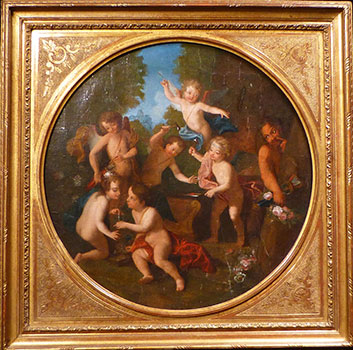
FROM THE COLLECTION OF HIS GRACE, THE LATE DUKE OF BUCKINGHAM AND CHANDOS AT STOWE HOUSE 12865. ALLAN RAMSAY, R.A., (of the Royal Academy), PORTRAIT OF A YOUNG GENTLEMAN IN BLUE COAT & WHITE STOCK. Provenance: The collection of a Southern gentleman. Verso 1. Verso 2. Verso 3.
LAJOS BARDOCZ, HUNGARIAN 12864. STILL LIFE WITH FLOWERS 1937. Oil on canvas, ~3 x 4 feet including frame. Provenance: The collection of a Southern gentleman, Ex the collection of the Hungarian National Gallery (white label on back was applied at the museum with its stamp. The stamp is half on and half off the label for security. Stamped twice. The painting was relined post-1960, probably by the museum. At the time of the relining, the painting was seated in a fine Louis XIV-style gilded frame of earlier date, probably the late 19th century, in which it remains currently. The painting is oversized for the frame, so a portion of the lower interior section was removed to accommodate the painting. About 4 inches of the painting is hidden there by the frame. The tag on back reads Magyar Nemzeti Galeria Budavari Palota, which translates to Hungarian National Gallery, which is the National Museum of Hungary. Verso 1. Verso 2.
J.P. MORGAN'S BUSINESS PARTNER 7575. FEDOR ENCKE, PORTRAIT OF JOHN H. HARJES, Oil on canvas, signed and dated Paris 1902. This is the companion portrait to Encke's famous portrait of J.P. Morgan painted at the same time. The two banking giants both had Encke paint their portraits at that time. Morgan's portrait was the one Encke was painting when the young Edward Steichen, at Encke's request to minimize sitting time, interrupted to take his iconic and controversial photograph of Morgan.
John H. Harjes, 1830-1914, was a prominent banker and the partner of J.P. Morgan and founder of the Morgan-Harjes Bank of Paris. He was the father of Henry H. Harjes, later banker and senior partner of the same bank who played a significant role behind the scenes in World War I by negotiating sizable loans for the Allies and by his major role in organizing relief work. Additional biographical material on Harjes can be found here.
Fedor Encke, German, 1851-1926, is a major artist whose works reside in a number of major museums in Europe and the United States.
This is an excellent large work which perfectly captures the spirit of fin de siecle opulence and financial power. Both the painting and its original ornate gilded frame are in excellent condition. Dimensions; 48 x 60" in the frame. This is an important historical painting in excellent condition which would be at home in a major museum or financial institution.
11612. THE ANGEL GABRIEL AT THE ANNUNCIATION. French or Italian, c. 16th-18th century. Oil on canvas. The Angel Gabriel holds Easter lilies, symbols of the annunciation. 22 x 28.5 inches. No visible signature. An important painting by a true master but in need of proper cleaning as it is darker than shown. Any information as to artist and date greatly appreciated. Back of canvas.
Not currently for sale.
SCULPTURE
IMPORTANT EARLY WORK BY NAM JUNE PAIK 7574. NAM JUNE PAIK. Korean American (1932 - 2006). Video Automaton 'PEDO'. Over life sized electronic sculpture. Paik is THE pioneer of Video Art. His sculpture has sold from $40,000 to well over $100,000 and is featured in museums such as the Whitney. This important early piece stands 80" high and weighs some 80lb. This is an early unsigned work by Paik before he was 'discovered' and rose to fame. I lived in Manhattan and it was in the early 70's that I used to watch Paik who had a regular program on a public access channel. This piece was prominently featured in those early shows with various camera feeds etc., often of Paik himself or his surroundings, being displayed through the monitor of this piece. This could be verified by reviewing tapes of these early broadcasts if they exist. Additionally we are not aware of anyone else producing early video art such as this. As such this may be an extremely important work, perhaps the earliest extant work by Paik and thus the earliest extant work of the video art genre. Of great historical interest to the history of 20th century art. Condition: The TV does turn on, however the other electronics need repair. There is also separation of one finger. This is a very heavy, bulky piece subject to special shipping. Front view. Left side view. Back view. Right side view.
EXHIBITED AT THE 1878 PARIS EXPOSITION UNIVERSELLE
EXHIBITED AT THE NEW ORLEANS MUSEUM OF ART12863. E. TANNIN, BRONZE BUST FROM THE 1878 PARIS EXPOSITION UNIVERSELLE. 17 x 34 inches. Bronze bust of the French symbol of Liberty, also known as Marianne, from the 1878 Paris Exposition Universelle. Marianne was the inspiration for the France's gift America, the Statue of Liberty. This bronze closely resembles the head of Liberty, which was exhibited at the Exposition the same year. Instead of the spiked crown of the liberty statue for America, we see a laurel surmounted by a five pointed star. Symbols of the arts and industries of France are emblazoned on the sash. The bronze has its original finish but shows evidence of past over-zealous cleaning of the base. Provenance: The collection of a Southern gentleman, exhibited at the New Orleans Museum of Art. Verso 1. Verso 2. Verso 3. Verso 4. Verso 5.
OCTAVIAN CAESAR AUGUSTUS 11422. ORIGINAL MARBLE BUST OF OCTAVIAN CAESAR AUGUSTUS BY PIETRO TENERANI, Signed and dated "TENERANI FEC ROM 1863.". A beautifully rendered original marble bust of the first Roman emperor Augustus as a young man, perhaps while still known as Octavian before he took the title of Augustus. An original signed and dated work by the famous Neoclassical sculptor Pietro Tenerani. Size bust alone 17.5 inches (44.5cm) high x 11.5 inches (29cm) wide x 9.5 inch (24cm) deep. 21.75 inch (55.5cm) high on socle. Life sized. Provenance: In the collection of a London family for the past 100 years. Front view. Signature. Shown to Christies London which confirmed its authenticity. A serious original artwork by a famous artist.
Pietro Tenerani (1789-1869), Italian neoclassical sculptor, has works displayed in major museums such as his beautiful Psyche in a Faint in the Hermitage. He studied in the studios of both Antonio Canova and Bertel Thorvaldsen and carried a neoclassical style into the mid-nineteenth century. His most prominent commission was for the tomb of Pope Pius VIII in Rome. Wikipedia article.

MAGNIFICENT VICTORIAN BRONZE SCULPTURE OF THE FAMOUS ROMAN POET AND CONFIDANT OF AUGUSTUS 8418. VICTORIAN BRONZE SCULPTURE OF HORACE. 19th century. 11 x 16.5 x 9 inches. 26 lbs. The great Roman poet depicted clothed in toga and wearing the poet's laurel crown, seated on a curule chair with pen and scroll on which is written "DEL ART / CHAMPETRE / HEUREUX QUI / DE SES MAINS / COMME NOS / PREMIERS PERES / CULTIVE EN PAIX / SES CHAMPS ET / VIT LIBRE / DíAFFAIRES. ORACE / ART" which roughly translates as: "Led happy pastoral art, which with their own hands our fore fathers cultivated their fields in peace and saw freedom in their affairs. Horace". Foundry stamp 3876 on back of base. Unsigned. Choice classical bronze with great detail even down to wolf heads ornamenting his sandals. Excellent condition. A masterpiece of classical Victorian sculpture.
8864. L. MORELLI. Italian, ca. 1920's. 'Reclining Girl With Tamborine'. Sculpture in white marble. Signed 'S. Morelli ñ Florence, Galleria Romanelli' on back of base. The bare chested dancing girl wearing only a loincloth with tassels. 15.75 inches on 5 x 17.75 inch base of beautifully patterned black and white marble which offers a perfect contrast to the figure. Choice condition and wonderful 'flapper' style. Front. Facing. Back. Signature.
RARE & ANTIQUARIAN BOOKS
NATURAL HISTORY
HUGE CHOICE AMBER NUGGET 12961. HUGE AMBER NUGGET. Sumatran amber, c. 20 million years BP. 24 kilograms, Measurements are 52 x 25 x 20 cm. The quality is excellent. This piece is free of cracks, chocolate color. Provenance: The property of a European gentleman. Originally found in Western Sumatra at a depth of 40 m. Back view. Another view. Another view.
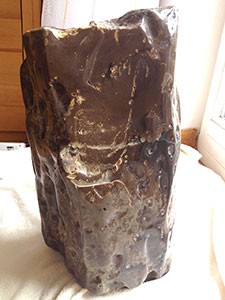
WORLD'S LARGEST? AMBER NUGGET 12937. COLOSSAL AMBER NUGGET. Sumatran amber, c. 20 million years BP. 48 kilograms, 60 x 62 x 37 cm. Hardness on Mohs scale 2.0. Thought to be the largest amber nugget known. The largest other amber nugget we have been able to document is another piece of Sumatran amber weighing 40 kilograms in the Museum of Jakarta. Provenance: The property of a European gentleman. Originally found in Western Sumatra at a depth of 40 m. Back view. Another view. Another view.
SOLD.

12900. MASSIVE FOSSIL LEPIDODENDRON STUMP. Carboniferous, between 300 million and 450 million years old. 18 1/2 inches across the top, 11 inches high, and 56 inches in circumference. Weight ~400 lbs. Extremely rare complete Lepidodendron stump. Provenance: A Tennessee fossil collection. Found on a privately owned farm in Campbell County, Tennessee. Enlargement. Another view. Another view. Another view.
Lepidondendrons were among the first large trees to appear on earth. These long extinct tall spore-bearing trees were related to modern club mosses. They stood in a dense, swampy forest 320 million years ago during the first the appearance of land animals. These Giant Club Moss trees somewhat resembled modern palms crowned with spiky fronds. The green trunks were textured like alligator skin, giving them the name "scale bark" trees.
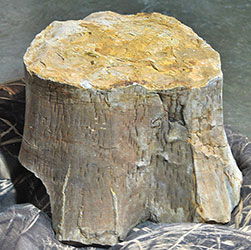
EXCEPTIONAL 17 KILOGRAM EXAMPLE! 11618. MASSIVE HUGE CHONDRITE METEORITE, Most probably from the NWA (North West Africa) 869 fall. 17 kilo, 37 lbs. 10 x 8 x 8.5 inches. ~95% good fusion crust with some desert patina deposits. With a number of old (they have desert sand grains wedged in them) cracks which appear to be stable. With good regmaglypts covering 4 of the 5 sides. Exceptionally rare. Meteorites this large are almost unheard of on the market. An extremely valuable example in spite of the old cracks. Provenance: Found in the Sahara desert. Side B.
